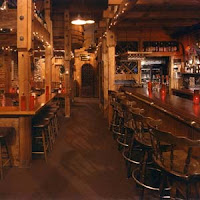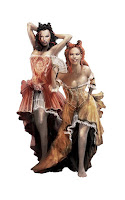Ruined, a play from Lynn Nottage, has a specific setting and plot that relates to the message portrayed to its audience. In the war stricken Democratic Republic of the Congo, Ruined tells us the story of a woman who runs the only business that pertains to men’s needs for miles. With a hard heart not open for business, Mama Nadi hides her true feelings and emotions until the end of the end of the tale where she unveils everything to her lovers.
As director my vision for the play would, while still carrying key themes from the original story, have a whole new approach. The environment would change to an Italian setting, with the year dating to the early 16th century, a corrupt era where politics took control and ruled with no opposition. Still using the foundations of Ruined, the majority of the play would take place in a whorehouse of the outskirts of Rome, Italy. I want the story of ruined to address the corruption of men, and women alike, through the greed of power and control. The government’s every move was controlled by the catholic church, and all those who rebelled of their “just” causes were shut up for good. A small group of renegades formed to revolt and soon become the force the people needed to fight back. While ruined portray an altogether sad melodrama, my vision is to have Mama Nadi and her girls as a part of this revolution, to confront the malicious drones of the Italian government.
 The location of the reenactment of Ruined should have no set theatrical space, but merely a collection of props and items that create the time era and feel to the play. A bar area for drinks, and a dancing space to compliment the room, as well as seating areas for the on looking customers. As long as the theatre space is enclosed and indoors, my acting cast and crew should be able to create the ideal environment for a story in an Italian renaissance. Audiences however are an entirely different matter, the play is going to be spoken in English, and is thus meant for American or European viewers. Particularly, like the original story of Ruined, I believe the play targets those who shut out others, who hide themselves for protection.
The location of the reenactment of Ruined should have no set theatrical space, but merely a collection of props and items that create the time era and feel to the play. A bar area for drinks, and a dancing space to compliment the room, as well as seating areas for the on looking customers. As long as the theatre space is enclosed and indoors, my acting cast and crew should be able to create the ideal environment for a story in an Italian renaissance. Audiences however are an entirely different matter, the play is going to be spoken in English, and is thus meant for American or European viewers. Particularly, like the original story of Ruined, I believe the play targets those who shut out others, who hide themselves for protection. Scenic Design is key to portraying the time and place of a story, and with a story like ruined based in an Italian setting, the environment needs to be spot on. Architecture is beyond a doubt how we can tell apart differing cultures, Italian civilizations of this time period utilize elegant shapes and decorations and placing these on stage can give spectators the feel as if they were there. The scene should tell the story of the background all on its own, with its style and age. Creating that style needs work, finding the materials to create props that portray the Italian culture of the 16th century wont come cheap either. The relation between the audience and the drama is formed with the scene, so I would have my actors use any prop or architecture to help tell the story.
Scenic Design is key to portraying the time and place of a story, and with a story like ruined based in an Italian setting, the environment needs to be spot on. Architecture is beyond a doubt how we can tell apart differing cultures, Italian civilizations of this time period utilize elegant shapes and decorations and placing these on stage can give spectators the feel as if they were there. The scene should tell the story of the background all on its own, with its style and age. Creating that style needs work, finding the materials to create props that portray the Italian culture of the 16th century wont come cheap either. The relation between the audience and the drama is formed with the scene, so I would have my actors use any prop or architecture to help tell the story. Costumes are just as important, if not far more, as the scene and setting. Costumes, much like the scene and props, establish time and place for a story to unfold, and also reveal personality and sometimes characteristics of each character. Mama Nadi’s girls for example, would wear revealing and more seductive outfits than that of say, a house wife.
Costumes are just as important, if not far more, as the scene and setting. Costumes, much like the scene and props, establish time and place for a story to unfold, and also reveal personality and sometimes characteristics of each character. Mama Nadi’s girls for example, would wear revealing and more seductive outfits than that of say, a house wife.  Social status too, is manifested from clothing, soldiers would wear mail and carry weapons but the common drunk would be in cloth or if he was wealthier, leather. My ideas for costumes would use braziers, or anything that could show off their curves for that matter, for the ladies of the story. Whereas the men, half of whom are soldiers, wore battle worn armor, and for characters like Christian the salesman, or Mr. Harabi, more of a noble-like attire.
Social status too, is manifested from clothing, soldiers would wear mail and carry weapons but the common drunk would be in cloth or if he was wealthier, leather. My ideas for costumes would use braziers, or anything that could show off their curves for that matter, for the ladies of the story. Whereas the men, half of whom are soldiers, wore battle worn armor, and for characters like Christian the salesman, or Mr. Harabi, more of a noble-like attire. Lighting creates mood, no one wants to see a sad story told with strobe lights flickering, we as an audience need dim lighting to create an eerie and uncomfortable feeling. Candle-lit rooms would be essential to the Italian reimagining of Ruined, there was no electricity during the time period, so at nighttime candles were all they had. However most of the play will be acted out as if it were daytime, so the lighting would be artificial seeing we are indoors, and everything would be well lit. For evening scenes though, the moonlight or candles would be used with some lighting from the crew so the audience can see the plot unfold.
Lighting creates mood, no one wants to see a sad story told with strobe lights flickering, we as an audience need dim lighting to create an eerie and uncomfortable feeling. Candle-lit rooms would be essential to the Italian reimagining of Ruined, there was no electricity during the time period, so at nighttime candles were all they had. However most of the play will be acted out as if it were daytime, so the lighting would be artificial seeing we are indoors, and everything would be well lit. For evening scenes though, the moonlight or candles would be used with some lighting from the crew so the audience can see the plot unfold.  Now a days we link music to mood, and vice versa, and without sound there is silence. While some plays use silence as it were necessary for the story, I plan to use music throughout the play, the setting is a brothel after all. When the girls of the business are dancing with the men, particulary the soldiers, my idea is to have a live singer like Sophie’s actor with an accompanying string or percussion instrument. Depending on which song played creates the setting, a slow song to create intimacy between a couple, or maybe a cheerful song to create joy. Outside the dancing and joy however, during dramatic scenes like Salima’s death I imagine a single, quiet violin playing to help reinforce the image being portrayed. It is with all of these key elements, scene, costume, lighting, and sound, created by their respective designer that we find meaning behind each characters action and reactions. They establish the environment, as well as the flow of the plot, and without them a story like Ruined would just seem so bland.
Now a days we link music to mood, and vice versa, and without sound there is silence. While some plays use silence as it were necessary for the story, I plan to use music throughout the play, the setting is a brothel after all. When the girls of the business are dancing with the men, particulary the soldiers, my idea is to have a live singer like Sophie’s actor with an accompanying string or percussion instrument. Depending on which song played creates the setting, a slow song to create intimacy between a couple, or maybe a cheerful song to create joy. Outside the dancing and joy however, during dramatic scenes like Salima’s death I imagine a single, quiet violin playing to help reinforce the image being portrayed. It is with all of these key elements, scene, costume, lighting, and sound, created by their respective designer that we find meaning behind each characters action and reactions. They establish the environment, as well as the flow of the plot, and without them a story like Ruined would just seem so bland.Felner, Mira, and Claudia Orenstein. The World of Theatre - Traditional and Innovation.
first. Boston MA: Pearson Education, Inc., 2006. 458. Print.
